Yes, safety goggles are required by law in certain situations
Safety goggles are a vital piece of personal protective equipment used to protect the eyes from potential hazards in the workplace, such as flying debris, chemical splashes, and intense light. While the requirement for safety goggles may vary depending on the specific industry and job, in many cases, they are indeed mandated by law.
Occupational Safety and Health Administration (OSHA) regulations
The Occupational Safety and Health Administration (OSHA) is a federal agency in the United States that sets and enforces safety regulations to ensure safe and healthy working conditions. OSHA requires employers to provide eye and face protection to employees when there is a risk of injury from hazards such as flying objects, particles, chemicals, and intense light.
According to OSHA’s Personal Protective Equipment (PPE) standard, employers must assess the workplace for potential eye hazards and provide the appropriate protective equipment, including safety goggles, to employees. Failure to comply with OSHA regulations can result in penalties and fines.
Specific industries and job tasks
While OSHA regulations provide general guidelines for eye and face protection, specific industries and job tasks may have additional requirements for safety goggles. For example, in industries such as construction, manufacturing, and laboratories, where there is a higher risk of eye injuries, safety goggles are typically mandatory.
Jobs that involve the use of power tools, corrosive substances, welding, grinding, or any activity that creates airborne particles or hazardous chemicals are prime examples of situations where safety goggles are required by law.
State and local regulations
In addition to federal regulations, state and local authorities may also have their own rules regarding safety goggles. These regulations can vary depending on the location, industry, and specific hazards present. It is essential for employers and employees to be aware of and comply with any state or local requirements for eye protection.
Some states, such as California, have stricter workplace safety regulations than the federal standards. In California, the California Division of Occupational Safety and Health (Cal/OSHA) sets and enforces specific rules for eye protection, including safety goggles.
The importance of wearing safety goggles
The use of safety goggles is not just a legal requirement; it is also crucial for protecting the eyes and preventing injuries. The eyes are extremely vulnerable to various hazards, including impact from objects, chemical exposure, and intense light. These hazards can cause severe damage, including vision loss.
Safety goggles provide a physical barrier to shield the eyes from potential dangers. They are designed to fit securely and comfortably, preventing particles or liquids from entering the eyes. Safety goggles also come with impact resistance and lens options, such as anti-fog coatings and UV protection.
By wearing safety goggles, workers can significantly reduce the risk of eye injuries and protect their long-term vision. Employers should provide appropriate eye protection and ensure that employees receive proper training on the proper use and maintenance of safety goggles. Employees, on the other hand, should comply with the requirements, wear the provided safety goggles, and report any damaged or malfunctioning equipment to their supervisors.






